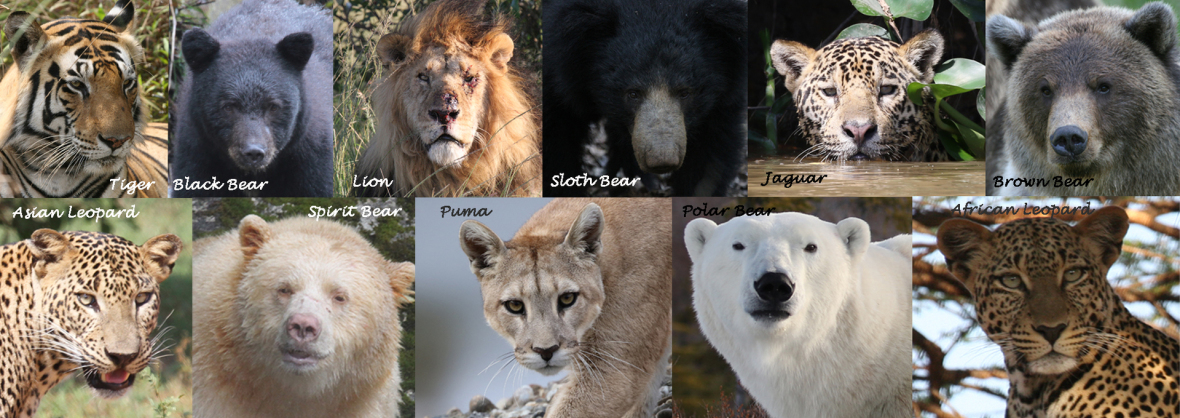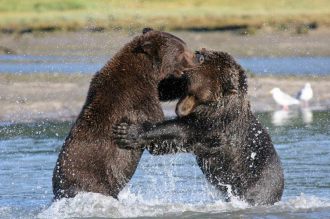

Bear Viewing Advice
The majority of organised bear viewing trips we have been on have included some form of bear awareness training. A great example is Katmai National Park, where as soon as your float plane has landed at Brooks Lodge you are taken straight to formal bear awareness training before you are allowed to walk anywhere on your own.
Although there is no guarantee you will see bears on an organised bear viewing trip, with local knowledge and experience it's obvious these will give you a higher chance of finding a bear. Of course not all bear searching and viewing has to be done under experienced supervision, you can find your own bears. We call these 'chance' bear viewings... 'chance' because they are just that, there's a chance you might see one! But with a bit of pre-planning you can greatly increase those chances.
WMTravellers' 'Chance' Bear Viewing Tips
Finding a bear...
- The best times to find bears is normally dawn and dusk as this is when the bears are usually travelling between their bedding sites and food sources. Although, bears can be sighted at any time of the day, this is when they are normally most active.
- Speak to locals or park rangers to find out where bears have been sighted recently. Some park rangers are reluctant to give out this information as they don't want too many people to visit known bear 'hot spots' - if you get vague answers speak to other visitors and ask what they have spotted and where.
- In national parks such as Yellowtone you may stumble across a carcass, this will likely attract bears, so if you have spotted one, watch and wait (from a safe distance) as it is likely that a bear will visit it (they have excellent noses).
- Look for crowds of people with large lenses as it is likely they have spotted a bear... and even if it's not a bear it is very likely to be something exciting like a wolf, badger, golden eagle.... Don't be afraid to ask a fellow visitor if you can look through their scope (no-one has ever said no to us!)
- Always carry your binos or scope so you can scan tree lines and valleys for brown or black dots that might be heading your way. Don't forget to look behind you too! We have had several experiences where everyone is looking on one side of the road and a bear has appeared on the other side!
Once you have 'found' that bear...
- First rule of bear viewing is - NEVER feed a bear!!! Feeding bears will encourage them to approach humans, this is never a good thing, they need to fear humans to keep them safe from hunters.
- ALWAYS stay a safe distance from the bear, if you are in a car, DON'T just stop in the road and cause a bear jam, try and find a safe place to pull over. STAY in your car if the bear is closer than 50 metres.
- NEVER try to get the bear's attention or disturb it from doing what it was doing. If the bear looks up and changes its behaviour you are probably too close, back away slowly. NEVER run and NEVER get between a sow bear and her cubs, she may see this as a threat to her babies.
- Getting pictures or video footage should never be at the cost of putting you or the bear at risk of injury! Some sightings should just stay as visual memories... know when to move on!
Unplanned chance encounters where you find yourself too close to the bear (for example on a trail)...
- If possible back away slowly and take a different route, either by back tracking or by going around the bear.
- If this is not possible or you are unexpectedly really close to the bear, stay calm and stand your ground, remember the bear is probably just as frightened of you as you are of it!
- If you are in group stay close together, the larger you appear the less likely the bear is to approach.
- Talk to the bear in a calm, 'comforting' tone. "Hello bear, I don't mean you any harm".
- Back away, walking slowly, don't run as this may trigger a 'hunting' instinct (bears are like cats and dogs, if something runs from them they will likely chase it).
- When a bear feels threatened it may swat the ground with its paws, 'pop' its jaw or even make a bluff charge towards you. Try to look non-threatening, remain calm and stay still. Keep talking to the bear and continue to slowly move away.
- In the unlikely event the bear makes contact with you, play dead by falling to the ground. Protect your stomach area by rolling onto it and place your hands on the back of your neck. Keep your legs and elbows in. Even when the attack is over remain in this position until you are sure the bear has moved on.
- In the even more unlikely event the bear starts to eat you, use whatever weapon you have to hand, kick and punch the bear. Its nose is really sensitive aim your attack for it or its eyes, fight for your life!
If the last two points above make you nervous about hiking in bear country, consider going on group hikes. If this is not possible, talk while you walk, especially through areas with lots of trees or long grass. Bears have good hearing, so give them warning you are approaching, if they know you are coming they will likely move off the trail to avoid you.
The largest concentration of bear numbers we have ever experienced was in Katmai National Park, near Brooks Falls. These were brown (grizzly) bears, at the very moment we were being given our bear awareness training a large bear walked right by the door of the hut, they came right up to our cabin grazing on the grass, the two of us walked to and from the viewing platforms on our own (talking as we walked) but I can honestly say we never felt afraid of the bears. Even when Alan experienced a bear slowly walking up to him while he was reading on our porch, other than being surprised, he never felt threatened. So don't let it worry you, there have only been 25 fatal bear attacks in North America in the last ten years, most of those were people camping or caused by getting too close to the bear in an attempt to get a better photo... just don't risk it!
For comprehensive bear safety advice visit the US National Park Service (NPS) through the link below.

